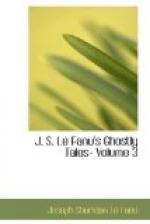She knocked again more violently, and shook the door with all her fragile force. It was something of horror in her countenance as she did so, that, no doubt, terrified Lady Mardykes, who with a loud and long scream sank in a swoon upon the floor.
The servants, alarmed by these sounds, were speedily in the gallery. Lady Mardykes was carried to her room, and laid upon her bed; her sister, Lady Haworth, accompanying her. In the meantime the door was forced. Sir Bale Mardykes was found stretched upon his bed.
Those who have once seen it, will not mistake the aspect of death. Here, in Sir Bale Mardykes’ room, in his bed, in his clothes, is a stranger, grim and awful; in a few days to be insupportable, and to pass alone into the prison-house, and to be seen no more.
Where is Sir Bale Mardykes now, whose roof-tree and whose place at board and bed will know him no more? Here lies a chap-fallen, fish-eyed image, chilling already into clay, and stiffening in every joint.
There is a marble monument in the pretty church of Golden Friars. It stands at the left side of what antiquarians call “the high altar.” Two pillars at each end support an arch with several armorial bearings on as many shields sculptured above. Beneath, on a marble flooring raised some four feet, with a cornice round, lies Sir Bale Mardykes, of Mardykes Hall, ninth Baronet of that ancient family, chiseled in marble with knee-breeches and buckled-shoes, and ailes de pigeon, and single-breasted coat and long waist-coat, ruffles and sword, such as gentlemen wore about the year 1770, and bearing a strong resemblance to the features of the second Charles. On the broad marble which forms the background is inscribed an epitaph, which has perpetuated to our times the estimate formed by his “inconsolable widow,” the Dowager Lady Mardykes, of the virtues and accomplishments of her deceased lord.
Lady Walsingham would have qualified two or three of the more highly-coloured hyperboles, at which the Golden Friars of those days sniffed and tittered. They don’t signify now; there is no contemporary left to laugh or whisper. And if there be not much that is true in the letter of that inscription, it at least perpetuates something that is true—that wonderful glorificaion of partisanship, the affection of an idolising wife.
Lady Mardykes, a few days after the funeral, left Mardykes Hall for ever. She lived a great deal with her sister, Lady Walsingham; and died, as a line cut at the foot of Sir Bale Mardykes’ epitaph records, in the year 1790; her remains being laid beside those of her beloved husband in Golden Friars.
The estates had come to Sir Bale Mardykes free of entail. He had been pottering over a will, but it was never completed, nor even quite planned; and after much doubt and scrutiny, it was at last ascertained that, in default of a will and of issue, a clause in the marriage-settlement gave the entire estates to the Dowager Lady Mardykes.




